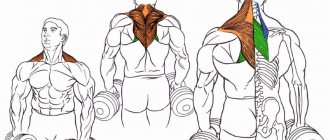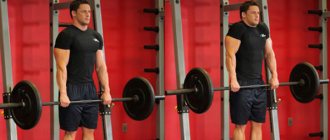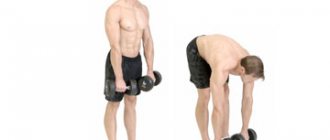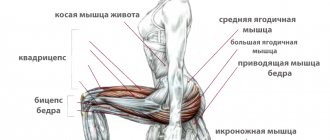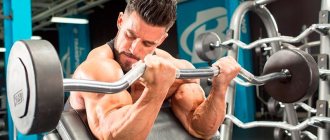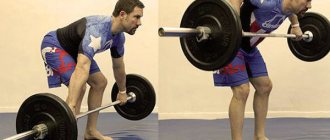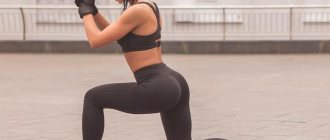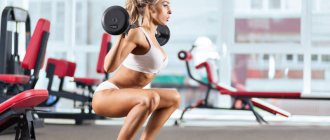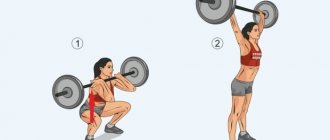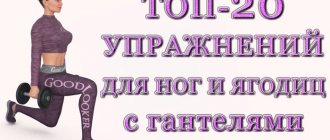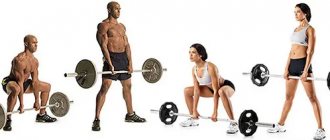Shrugs are included in a strength training program to develop and increase the size of the upper trapezius muscle. There are many variations of the exercise, which allows it to be included in the training of both beginners and experienced athletes. The main goal of the exercise is to develop your back comprehensively and harmoniously. Shrugs are not the most popular and sought-after exercise, but they are very effective. Let's look at shrugs: what they are, what are their benefits, how to do them correctly and what results can be achieved.
Benefits and Benefits
One of the most effective exercises for the trapezius is the dumbbell shrug.
Shrugs with dumbbells and barbells differ in two ways:
- range of motion:
- grip
Most athletes find it much easier to do shrugs with dumbbells than with a barbell because the vector of movement is directed along the line of the body, and not in front of it. This way, you train more muscle fibers and ultimately get better results in building muscle mass and increasing strength.
What muscles work
- Trapezius muscle (mainly upper part).
- Rhomboid muscle.
- The levator scapulae muscle.
The biceps brachii muscles, muscles of the forearm and hand work as stabilizers when holding the grip.
Types of shrugs with dumbbells
Types of dumbbell shrugs vary depending on the starting position. Let's look at the most common ones.
Standing dumbbell shrugs
The most common form of this exercise is the standing dumbbell shrug.
Advantages : the ability to use a fairly large weight, comfortable range of motion.
Disadvantages : axial load on the spine, combination of stabilizing muscles for working with heavy dumbbells.
Shrugs with dumbbells while sitting
This method is indispensable if the axial load on the spine is unacceptable or requires reduction. This eliminates cheating, bending and pushing. Seated shrugs are technically more difficult; many people cannot achieve maximum muscle contraction in this position and therefore cannot train their muscles effectively.
Bent-over dumbbell shrugs
This option focuses on the back of the trapezius muscles.
Advantages : better development of the back of the trapezius.
Disadvantages : technical complexity, large axial load on the spine, limited range of motion.
Shrugs while lying on an incline bench
This version of the exercise is the least traumatic for the spine, but requires the use of only light weights, since the position of the joint is not natural for performing shrugs.
Benefits : improved posture by strengthening the muscles of the mid-back, giving the trapezius a more peaked shape, no axial load on the spine.
Disadvantages : risk of injury (carelessness can easily damage the shoulder joint).
Shrugs with a barbell
To perform this type of shrug, more serious weights are used. It is not recommended to start performing without a safety weightlifting belt, wrist straps and gloves. There is a risk of injury.
Shrugs with a barbell technique:
- starting position: it is recommended to take the bar with a grip slightly wider than shoulder width. We align the body, reach the top of the head towards the ceiling, and shoulders towards the floor. There is a slight natural curve in the lower back. We look straight ahead. Arms straight;
- as you exhale - with the force of the trapezius, the shoulders rise up, fixing at the extreme point for a couple of seconds and smoothly returning to the starting position;
- It is very important to ensure that your arms are straight, that your torso is not tilted, and that your knees are not bent. You just need to shrug your shoulders, reaching the peak contraction at the top point.
Explanations
- While working, look at yourself in the mirror. Looking straight ahead will help prevent slouching. Tilts of the head to the right/left will lead to asymmetrical development of the trapezius.
- Avoid slouching. It will be easy to keep your shoulders in the correct position with your back and chest straightened.
- If you feel that you cannot keep your shoulders abducted, then for now work only with dumbbells.
- We try to raise our shoulders as high as possible.
- Holding your breath while raising your shoulders helps stabilize your torso.
- The pursuit of weight, at best, will result in a lack of effectiveness. A large load will not allow a person with poor training to perform the exercise correctly, reducing the amplitude. In the worst case scenario, the result of such haste will be injury.
- We do not allow the shoulders to make rotational movements.
Everyone decides for themselves whether to perform shrugs with dumbbells or with a barbell. It all depends on preparation, preferences and goals.
Execution technique
It's best to start with light weights to better focus on the neuromuscular connection. To isolate the trapezoid as much as possible, use wrist straps or hooks.
- Straighten your back, look ahead.
- If you do shrugs while sitting on a bench . Without changing the position of the body, sit on a bench and place the dumbbells.
- If you do bent over shrugs . Bend about 45 degrees and move your pelvis back slightly.
- If you do incline shrugs . Lie down on a bench so that your thoracic spine does not bend under the weight of the dumbbells.
- Raise the dumbbells as you exhale. The movement is performed only by raising the shoulders up. The movement should go smoothly, focusing on reducing the trapezoidal peak. The amplitude should be as high as possible. The shoulder muscles, biceps or latissimus dorsi should not be included. Try not to bend your elbows - this also applies to your biceps and forearms, and the trapezius has less blood supply. Do not circle your arms at the top as this can damage your rotator cuff.
- Gently lower the dumbbells, inhale and feel the muscle tension.
Recommendations for performing the exercise
Despite their simplicity, shrugs have their own nuances:
- We have already noted that you should not “drop” your shoulders. If you push them down sharply every time, there will be a significant load on the joints, which can harm them.
- In addition, you should not lower your shoulders too low in principle. If you feel a stretch, that's not a good thing, and again you could injure yourself.
- Rotational or lateral movements are another way to damage joints.
- Do not help yourself with your biceps, do not bend your elbows.
- The head should be pointed straight.
- Do not start shrugs at the beginning of your back workout, use them as the final stage. In any case, you first need to warm up and prepare your muscles; to do this, do at least 2 sets of pull-ups on the horizontal bar.
Shrugs are most often practiced by professional and experienced athletes when they want to achieve an ideal upper back shape. But it’s also worth trying if you need to get rid of stoop, develop and strengthen muscles. Girls who do not want to part with the grace of their necks and beginners should avoid shrugs.
Common mistakes
- Violation of the amplitude of movement. This means that the amplitude is too small, so the lift height is not enough to reduce the trapezoid. Getting rid of the error is quite simple. With each repetition, you need to imagine that you are trying to reach your ears with your shoulders. There is another option: you need to practice the exercise with less weight.
- Perform the movement by pressing your chin to your chest. The mistake allows you to overstretch the neck muscles and can lead to a pinched nerve. And for most people this does not achieve results.
- Biceps Curl. This movement only removes part of the load from the trapezius, allowing the arms to move by inertia. Bicep curls can also cause injury to the elbow and wrist. Therefore, it is necessary to monitor the position of the hand in the exercise.
- Excessive training of the trapezius muscles. Many people think that the trapezius is a small muscle group and recovery does not take much time. This is a common misconception. The trapezius should not be trained more than once a week. This frequency results in the most progress.
- Ignoring the belt if your back is weak. When using the maximum weight, it is important not to forget about the belt. This will not only avoid technical errors, but also maintain your back health.
Shrugs on uneven bars
In addition to the above options, shrugs can also be performed on regular parallel bars.
Technique:
Take a position on straightened arms on parallel bars. The torso should be positioned strictly vertically and not lean forward or backward during the entire exercise. The starting position is to maintain a straight body, without lowering yourself and raising your shoulders.
As you exhale, push your torso up, and as you inhale, return back to the starting position.
Shrugs on parallel bars are effective, like an exercise with dumbbells or a barbell, and work the trapezius perfectly. The difference is that the weight is directly your own body weight. If your body weight is insufficient, you can add additional weights, such as by wearing a weight belt or a weighted vest.
Final tips
Well, in conclusion, a few tips that will allow you not to worry about overtraining or undertraining something.
- Build your training program around the simplest exercises. Squat, pick something off the floor, pull something towards you, push something away from you. You'll be fine because these exercises work a lot of muscles at once in a natural proportion for the body.
- Use free weights whenever possible. And you won't have to worry about developing small muscles and stabilizer muscles. This way, you will minimize the risk of injury by preventing the emergence of weak links, in the form of lagging muscles, in your body.
- As a complement to simple compound exercises, use isolation exercises to train the muscles you want to tone. Example: if you did a deadlift or Romanian, do leg curls and/or hyperextensions. This way you will work the target muscles separately, which will give them an additional incentive to grow.
- Don't panic, even if you try very hard, you won't be able to pump anything into yourself. Our female body is designed in such a way that rapid muscle growth is not our priority. And if your training program is well-structured and consists of simple and effective exercises, then there is nothing to worry about. Just train and watch how your body transforms.
In the sun
Sun drying is the easiest way to prepare bananas.
- Line a baking sheet or tray with wax paper and spread the prepared fruit evenly on it.
- To protect from dust and insects, cover the cutter with a clean cloth and place the container in the sun. Optimal conditions for drying fruits in air are a temperature of about +25 ... +30 ° C and a humidity of no more than 65%.
- On the first day, be sure to turn the drying product every 1.5–2 hours. The rest of the time, carry out this procedure at least 3-4 times a day.
Depending on weather conditions and the size of the pieces, drying may take 2 to 4 days. Remember to bring the pan indoors at night or when it rains. Otherwise, the product will become soggy and spoiled.
Anatomy of the trapezius muscles
The trapezius is located in the upper back and is adjacent to the neck muscles on top. Visually it can be divided into three parts:
- The upper one is adjacent to the neck and is responsible for raising the shoulders upward.
- The middle one is between the shoulder blades and is involved in lifting the shoulder blades.
- Lower - in the lower part of the shoulder blades, responsible for lowering the scapular bones in the lower phase of movement.
decade3d - stock.adobe.com
Keeping trapezius in good shape is necessary for any athlete. This will increase your strength in basic exercises, reduce the load on the shoulder joints and ligaments, reduce the curvature of the spine in the cervical region and minimize the risk of damage and injury to the entire shoulder girdle.
Leg extension in the simulator
Beautiful legs are something that no girl will refuse. It is for them that many of us come to the hall. How many different exercises do we know? Squats, bends, rows, leg curls, bridges and lunges. Leg abductions and abductions, and much more. Many of us also do not bypass the leg extension machine, which specifically loads the quadriceps - the muscles located on the front side of the thighs. But is it worth paying special attention to them?
If we consider women's legs from an aesthetic point of view, then it is probably still worth avoiding their resemblance to men's. Beautiful thighs are what we need, so girls should pay extra attention to the development of the back of their legs - the thighs and calf muscles. You should not overload the front of the thigh and allow overdevelopment of the quadriceps, as you can get the effect of massive thighs and something similar to “golifa.” Leave the bulging quads to the men who show them off as they show off their squat successes. We have other interests.
Any exercises for the obliques
Remember: if you pump up your oblique abdominal muscles with particular enthusiasm, you can get an unpleasant “bonus” in the form of a wide waist. Yes, yes, unfortunately, this is true, but it is not magic - you pump up the muscles that are located at the waist, they become thicker and you gain additional centimeters to the waist. Why do you need this? Are you saying that you want to develop all your muscles harmoniously? So there is no problem with this - continue to do squats and deadlifts, pump your abs, and you will get the development of your core muscles exactly to the extent you need. At the same time, you won’t be able to harm your waist with a couple of extra centimeters. The tone will be as needed. And you won't have to worry about excess hypertrophy.
